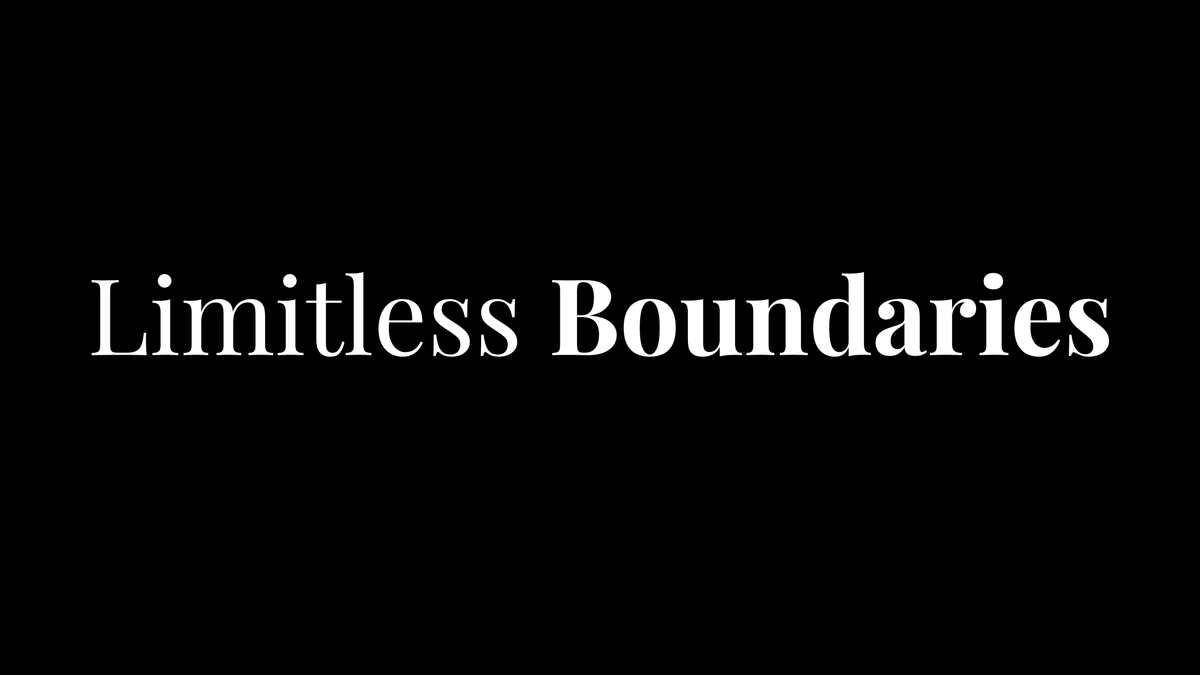Limitless Boundaries: The Power of No That Protects Your Vision
Tired of saying "yes" to everything but achieving little? Learn how strategic boundaries can protect your energy, sharpen your focus, and unlock your highest-impact work—without the guilt of saying "no".

There was a time in my entrepreneurial journey when my days were overflowing with commitments. Projects I agreed to help with, clients who weren't truly aligned with my vision, and endless "quick coffee chats." I said yes to every request for help, every potential collaboration, every opportunity that seemed like it might lead somewhere.
Hustle culture had me convinced that success meant taking on more, helping everyone, and never turning down work. Each "yes" felt like forward momentum.
But eventually, I found myself spread impossibly thin. My energy was depleted. The work that once energized me became a source of dread. I was helping so many people and taking on so many projects, yet accomplishing so little of what actually mattered to me.
The turning point came when I realized that every "yes" was actually a "no" to something else—often to the core work that would truly move my vision forward. Over time, I've refined my brand and my focus by becoming increasingly selective about the projects I take on, the clients I work with, and even the coffee chats I agree to.
Boundaries don’t fence me in—they free me.
Today's edition is about that journey we all face: learning to set boundaries that protect what matters most. Because when you're clear about your limits, you create unlimited potential for the work that truly matters to you.
WHY BOUNDARIES MATTER
Boundaries aren't walls, they're gate keepers. They don't limit your opportunities; they open the doors to only the ones that align with your vision.
For founders, boundaries serve three critical functions:
- They protect your most valuable resource: energy. When you say "no" to draining commitments, you preserve energy for your highest-impact work.
- They sharpen your focus. Clear boundaries eliminate the cognitive load of constant context-switching and decision fatigue.
- They communicate your values. The boundaries you set signal to yourself and others what you truly prioritize, not just what you say you prioritize.
Think of boundaries as the invisible architecture that shapes your day, your relationships, and ultimately, your success.
TYPES OF BOUNDARIES EVERY FOUNDER NEEDS
Time Boundaries
- Calendar blocking: Designate specific times for deep work, meetings, and personal recovery. Treat these blocks as non-negotiable commitments.
- Response windows: Set expectations for when you'll respond to messages. Not everything requires immediate attention.
- Meeting protocols: Establish clear start and end times, require agendas, and don't hesitate to decline meetings that could be emails or a quick whatsapp reply.
People Boundaries
- Client parameters: Be explicit about when and how you're available, what services you provide, and what falls outside your scope.
- Team communication: Create channels and times for different types of communication to minimize constant interruption.
- Energy vampires: Identify relationships that consistently drain you and limit your exposure or restructure these interactions.
Work/Project Boundaries
- Strategic alignment: Before committing to any project, ask: "Does this directly advance my primary mission?" If not, reconsider.
- Scope definition: Clearly outline what is and isn't included in each project to prevent scope creep.
- Value-based pricing: Set rates that reflect the true value of your time and expertise, not just what you think the market will bear.
Digital Boundaries
- Notification management: Turn off non-essential notifications. Your attention is too valuable to be hijacked by every ping.
- Digital detox periods: Designate times when you're completely disconnected from devices to allow for true recovery and deep focused work.
- Platform limitations: Be intentional about which platforms you engage with and for how long each day.
PRACTICAL IMPLEMENTATION: THIS WEEK'S CHALLENGE
Start small. Choose ONE boundary from each category to implement this week:
1. Practice the "24-Hour Rule"
When presented with a new opportunity, commit to waiting 24 hours before responding. This creates space to evaluate whether it truly aligns with your priorities rather than responding from a place of FOMO or people-pleasing.
2. Create a "Not Doing" List
Alongside your to-do list, maintain a "not doing" list. These are tasks, projects, or activities you're consciously choosing to decline or delegate. Review this list when you feel pulled in too many directions.
3. Implement Tech-Free Mornings
Keep your phone on airplane mode for the first hour after waking. Use this time for reflection, planning, or personal practices that ground you before the demands of the day begin.
Setting boundaries isn't selfish—it's strategic.
Each boundary you establish is an investment in your vision's long-term success.
RESOURCE OF THE WEEK
Book Recommendation: "Essentialism" by Greg McKeown
McKeown's philosophy of "less but better" provides a framework for identifying what's truly essential in your work and life. His practical approaches to saying "no" gracefully and focusing on your "highest point of contribution" align perfectly with boundary-setting practices.
WEEKLY REFLECTION
Take five minutes to consider:
- What recurring activity or commitment is consuming my energy without meaningfully advancing my vision?
- What would happen if I eliminated—or drastically reduced—this for 30 days?
- What specific boundary can I set this week to reclaim this energy?
FINAL THOUGHT
"The difference between successful people and very successful people is that very successful people say 'no' to almost everything." — Warren Buffett
Here's to your limitless life, the joy is in the journey!
Kelli




